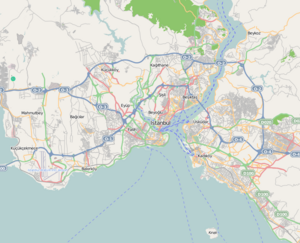
Back Mure van Konstantinopel Afrikaans أسوار القسطنطينية Arabic Konstantinopol divarları Azerbaijani Константинополски стени Bulgarian Muralles de Constantinoble Catalan Феодосийн пенаш CE Konstantinopolské hradby Czech Theodosianische Mauer German Τείχη της Κωνσταντινούπολης Greek Murallas de Constantinopla Spanish
| Walls of Constantinople | |
|---|---|
| Istanbul, Turkey | |
 A part of the restored and renovated Walls of Constantinople with towers in the Fatih-Zeytinburnu district border | |
 | |
| Coordinates | 41°00′44″N 28°58′34″E / 41.0122°N 28.9760°E |
| Type | Walls |
| Height | Up to 12 m |
| Site information | |
| Owner | Turkey |
| Controlled by | Roman Empire, Byzantine Empire, Latin Empire, Ottoman Empire |
| Open to the public | Yes |
| Condition | Land walls partly ruined, sea walls largely torn down; Restoration work underway by the Istanbul Municipality. |
| Site history | |
| Built | 4th–5th centuries, with later restorations and additions |
| Built by | Septimius Severus, Constantine I, Constantius II, Theodosius II, Justinian I, Heraclius, Leo V, Theophilos, Manuel I Komnenos |
| Materials | Limestone, brick |
| Battles/wars | Avar-Persian siege of 626, First and Second Arab sieges, Revolt of Thomas the Slav, Fourth Crusade, Second and final Ottoman siege |
| Type | Cultural |
| Criteria | i, ii, iii, iv |
| Designated | 1985 (9th session) |
| Part of | Historic Areas of Istanbul |
| Reference no. | 356 |
| Region | Europe and North America |
The Walls of Constantinople (Turkish: Konstantinopolis Surları; Greek: Τείχη της Κωνσταντινούπολης) are a series of defensive stone walls that have surrounded and protected the city of Constantinople (today Istanbul in Turkey) since its founding as the new capital of the Roman Empire by Constantine the Great. With numerous additions and modifications during their history, they were the last great fortification system of antiquity, and one of the most complex and elaborate systems ever built.
Initially built by Constantine the Great, the walls surrounded the new city on all sides, protecting it against attack from both sea and land. As the city grew, the famous double line of the Theodosian Walls was built in the 5th century. Although the other sections of the walls were less elaborate, they were, when well-manned, almost impregnable for any medieval besieger. They saved the city, and the Byzantine Empire with it, during sieges by the Avar–Sassanian coalition, Arabs, Rus', and Bulgars, among others. The fortifications retained their usefulness after the advent of gunpowder siege cannons, which played a part in the city's fall to Ottoman forces in 1453 but were not able to breach its walls.
The walls were largely maintained intact during most of the Ottoman period until sections began to be dismantled in the 19th century, as the city outgrew its medieval boundaries. Despite lack of maintenance, many parts of the walls survived and are still standing today. A large-scale restoration program has been underway since the 1980s.
